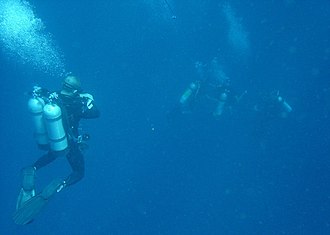

The decompression of a diver is the reduction in ambient pressure experienced during ascent from depth. It is also the process of elimination of dissolved inert gases from the diver's body which accumulate during ascent, largely during pauses in the ascent known as decompression stops, and after surfacing, until the gas concentrations reach equilibrium. Divers breathing gas at ambient pressure need to ascend at a rate determined by their exposure to pressure and the breathing gas in use. A diver who only breathes gas at atmospheric pressure when free-diving or snorkelling will not usually need to decompress. Divers using an atmospheric diving suit do not need to decompress as they are never exposed to high ambient pressure.
When a diver descends in the water, the hydrostatic pressure, and therefore the ambient pressure, rises. Because breathing gas is supplied at ambient pressure, some of this gas dissolves into the diver's blood and is transferred by the blood to other tissues. Inert gas such as nitrogen or helium continues to be taken up until the gas dissolved in the diver is in a state of equilibrium with the breathing gas in the diver's lungs, at which point the diver is saturated for that depth and breathing mixture, or the depth, and therefore the pressure, is changed, or the partial pressures of the gases are changed by modifying the breathing gas mixture. During ascent, the ambient pressure is reduced, and at some stage the inert gases dissolved in any given tissue will be at a higher concentration than the equilibrium state and start to diffuse out again. If the pressure reduction is sufficient, excess gas may form bubbles, which may lead to decompression sickness, a possibly debilitating or life-threatening condition. It is essential that divers manage their decompression to avoid excessive bubble formation and decompression sickness. A mismanaged decompression usually results from reducing the ambient pressure too quickly for the amount of gas in solution to be eliminated safely. These bubbles may block arterial blood supply to tissues or directly cause tissue damage. If the decompression is effective, the asymptomatic venous microbubbles present after most dives are eliminated from the diver's body in the alveolar capillary beds of the lungs. If they are not given enough time, or more bubbles are created than can be eliminated safely, the bubbles grow in size and number causing the symptoms and injuries of decompression sickness. The immediate goal of controlled decompression is to avoid development of symptoms of bubble formation in the tissues of the diver, and the long-term goal is to avoid complications due to sub-clinical decompression injury.
The mechanisms of bubble formation and the damage bubbles cause has been the subject of medical research for a considerable time and several hypotheses have been advanced and tested. Tables and algorithms for predicting the outcome of decompression schedules for specified hyperbaric exposures have been proposed, tested and used, and in many cases, superseded. Although constantly refined and generally considered acceptably reliable, the actual outcome for any individual diver remains slightly unpredictable. Although decompression retains some risk, this is now generally considered acceptable for dives within the well tested range of normal recreational and professional diving. Nevertheless, currently popular decompression procedures advise a 'safety stop' additional to any stops required by the algorithm, usually of about three to five minutes at 3 to 6 metres (10 to 20 ft), particularly 1 on an otherwise continuous no-stop ascent.
Decompression may be continuous or staged. A staged decompression ascent is interrupted by decompression stops at calculated depth intervals, but the entire ascent is actually part of the decompression and the ascent rate is critical to harmless elimination of inert gas. A no-decompression dive, or more accurately, a dive with no-stop decompression, relies on limiting the ascent rate for avoidance of excessive bubble formation in the fastest tissues. The elapsed time at surface pressure immediately after a dive is also an important part of decompression and can be thought of as the last decompression stop of a dive. It can take up to 24 hours for the body to return to its normal atmospheric levels of inert gas saturation after a dive. When time is spent on the surface between dives this is known as the "surface interval" and is considered when calculating decompression requirements for the subsequent dive.
Efficient decompression requires the diver to ascend fast enough to establish as high a decompression gradient, in as many tissues, as safely possible, without provoking the development of symptomatic bubbles. This is facilitated by the highest acceptably safe oxygen partial pressure in the breathing gas, and avoiding gas changes that could cause counterdiffusion bubble formation or growth. The development of schedules that are both safe and efficient has been complicated by the large number of variables and uncertainties, including personal variation in response under varying environmental conditions and workload.